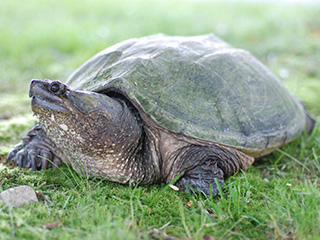Risk of Releasing Painted Turtle Back Into Natural Environment
snapping turtle © Joy Marzolf, Mass Audubon
Turtles often find themselves navigating developed areas—you may find a turtle crossing a busy road, or laying eggs in your yard. We can help you decide when to intervene. In most cases, turtles should be left alone, and we also discourage people from taking wild turtles as pets.
Turtles Crossing Roads
In late spring and early summer, adult female turtles cross roads in search of nest sites. Each species has a different habitat requirement, but when searching for a nest site they usually choose sandy or loose soil in lawns, tilled or mowed fields, roadsides, and occasionally backyard compost piles.
It is often assumed that something is wrong when a turtle is crossing the road. People, with best intentions, mistakenly attempt to return it to water, take it home, or, take it somewhere that seems safer and release it. But the best thing to do is leave it alone. The turtle knows where it wants to go and may have been nesting in the same spot for many years—or even decades.
If a small turtle is in danger of being hit by cars, it can be moved in the direction it was headed, to the other side of the road. Snapping turtles can be dangerous and should not be handled. They are surprisingly fast for their size and can extend their necks the length of their carapace. NEVER pick up a snapping turtle by the tail because you could seriously injure it.
Turtles Laying Eggs in Yards
Turtles that are looking to lay eggs frequently wander into yards, especially those near ponds, lakes, and rivers. These animals should not be disturbed, but can be observed from a distance.
People often ask whether they should protect a turtle's nest with fencing. This is not an easy question to answer. Predators that seek turtle eggs are usually a natural part of the environment. If you wish, you may flag the site in order to locate it in the fall and possibly observe the hatchlings.
Wild Turtles in Captivity
A serious threat to turtle populations has been the collection of turtles as pets. By law, only two species of turtles may be taken from the wild: snapping turtles and painted turtles. However, Mass Audubon discourages people from taking any turtle from the wild for the following reasons:
- It reduces local populations.
- If the owner grows tired of the responsibility and releases a turtle back into the wild, the animal may not survive, depending on the age when it was captured, the length of time in captivity, and the location of its release.
- Turtles need special care so that they don't suffer from skin infections and shell abscesses. Improper nutrition may result in eye disease, the softening of the shell, and the loss of bone mass.
Turtle Species in Massachusetts
There are 10 species of turtles in Massachusetts. They range from the tiny bog turtle, which measures 3-4" long, to the snapping turtle, which can reach up to 19" long. In addition, five sea turtles have also been found offshore or stranded on beaches. Learn More
Turtles and the Law
Massachusetts law makes it illegal to possess any turtle listed on the state and/or federal endangered species list. Although it is legal to collect some turtle species, we discourage anyone from doing so. No turtles, including snapping turtles, can be caught and sold for food without a permit from the state.
If you find a turtle that is listed under the Massachusetts Endangered Species Act, take a picture to confirm the identification, and notify the Natural Heritage and Endangered Species Program.
Risk of Releasing Painted Turtle Back Into Natural Environment
Source: https://www.massaudubon.org/learn/nature-wildlife/reptiles-amphibians/turtles/situations-solutions
0 Response to "Risk of Releasing Painted Turtle Back Into Natural Environment"
Post a Comment